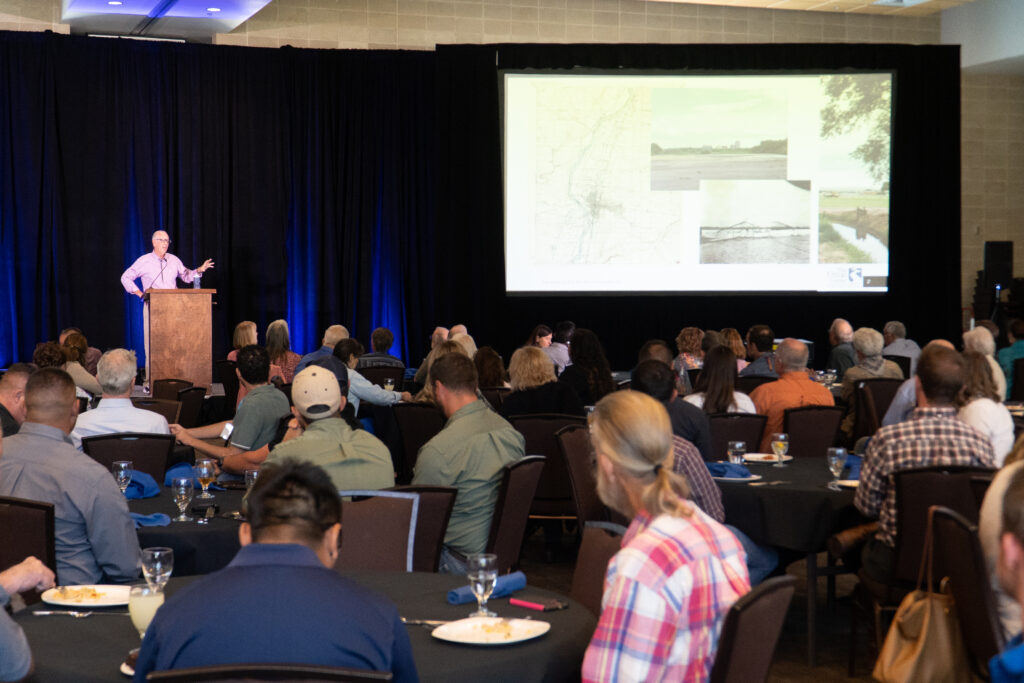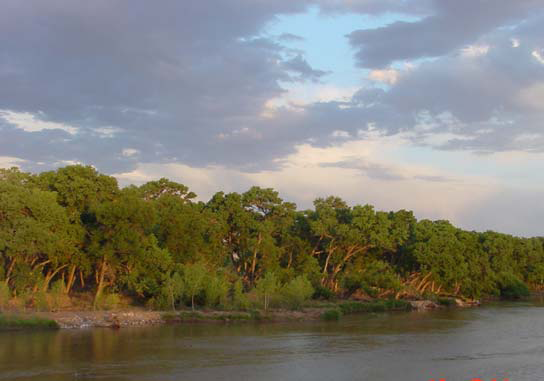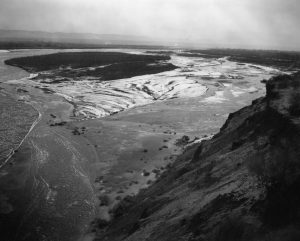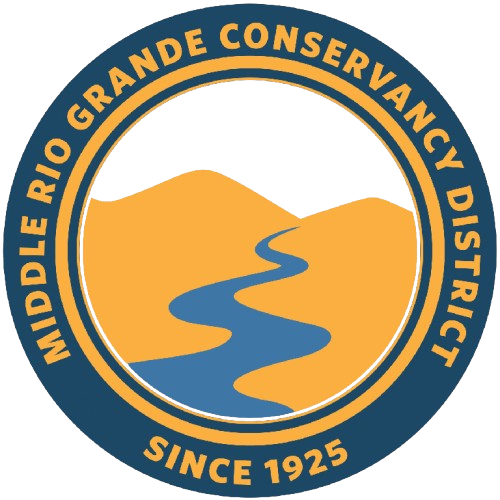History
NEW MEXICO CONSERVANCY ACT CENTENNIAL.

In 1923 the New Mexico Legislature passed the Conservancy Act, a law that changed the Middle Rio Grande Valley forever. One hundred years later, MRGCD brought more than 100 community and industry leaders together to talk about that past and think about our shared future. The luncheon included a presentation by John Fleck, Writer in Residence at the University of New Mexico’s Utton Center, on the challenges the valley’s communities faced a century ago in making a life alongside the Rio Grande, and how the Conservancy Act helped shape what those communities have become.
View event photos here
View Mr. Fleck’s presentation here
THE RIO GRANDE: A RIBBON OF LIFE AND TRADITION.
 The Rio Grande has been the source of life-giving water for civilizations in New Mexico for as long as people have lived here. When Vasquez de Coronado first reached the pueblos of the middle Rio Grande valley in 1540, he found that the native communities had been irrigating extensively for hundreds of years. Today, the Rio Grande remains an indispensable water source that provides for the livelihood of thousands, but it is also much more. The Rio Grande has become a powerful symbol of tradition and history for many local communities. The river is a valuable part of the lives and history of the hundreds of thousands of people that make central New Mexico their home. What many do not realize, however, is that the Rio Grande is still a wild river. It can still be heavily affected by climatic and ecological change and requires constant maintenance and monitoring by those around it. Here, in the heartland of New Mexico, the Middle Rio Grande Conservancy District (MRGCD) is charged with this responsibility. This 80-year-old organization diligently maintains and rehabilitates the intricate systems of ditches and canals and levees that prevent the Rio Grande from overflowing its banks while also allowing for irrigation, agriculture, recreation, and environmental sustainability.
The Rio Grande has been the source of life-giving water for civilizations in New Mexico for as long as people have lived here. When Vasquez de Coronado first reached the pueblos of the middle Rio Grande valley in 1540, he found that the native communities had been irrigating extensively for hundreds of years. Today, the Rio Grande remains an indispensable water source that provides for the livelihood of thousands, but it is also much more. The Rio Grande has become a powerful symbol of tradition and history for many local communities. The river is a valuable part of the lives and history of the hundreds of thousands of people that make central New Mexico their home. What many do not realize, however, is that the Rio Grande is still a wild river. It can still be heavily affected by climatic and ecological change and requires constant maintenance and monitoring by those around it. Here, in the heartland of New Mexico, the Middle Rio Grande Conservancy District (MRGCD) is charged with this responsibility. This 80-year-old organization diligently maintains and rehabilitates the intricate systems of ditches and canals and levees that prevent the Rio Grande from overflowing its banks while also allowing for irrigation, agriculture, recreation, and environmental sustainability.
THE MRGCD: FOR THE BENEFIT OF NEW MEXICO.
 At the time of the Conservancy’s creation in 1923, the flow of the Rio Grande through central New Mexico fluctuated dangerously and unpredictably. Development and deforestation in Colorado, since the 1880s, had raised the levels of silt in the river, which led to increased sedimentation. These deposits then began to collect in the middle Rio Grande valley—where theriver first widens and slows—thus raising the level of the riverbed and the surrounding water table. The shallow water table throughout the valley turned over 60,000 acres of farmland into swamps or alkali and salt grass fields. Frequent floods often destroyed entire villages; one scoured a path right through what is now downtown Albuquerque. Also, the existing irrigation systems were insufficient and primitive; many were hundreds of years old and desperately needed rehabilitation. The MRGCD was created to provide flood protection from the Rio Grande, drain swamp lands and provide irrigation water to farmlands. By 1935, the Conservancy District had built the storage dam at El Vado and the diversion dams at Cochiti, Angostura, Isleta, and San Acacia to manage its water. The Conservancy had also dug 17 miles of new drainage and irrigation canals, and incorporated another 214 miles of existing canal into the system. Nearly 200 miles of riverside levees and a system of jetties and checks alongside the river protected against floods.
At the time of the Conservancy’s creation in 1923, the flow of the Rio Grande through central New Mexico fluctuated dangerously and unpredictably. Development and deforestation in Colorado, since the 1880s, had raised the levels of silt in the river, which led to increased sedimentation. These deposits then began to collect in the middle Rio Grande valley—where theriver first widens and slows—thus raising the level of the riverbed and the surrounding water table. The shallow water table throughout the valley turned over 60,000 acres of farmland into swamps or alkali and salt grass fields. Frequent floods often destroyed entire villages; one scoured a path right through what is now downtown Albuquerque. Also, the existing irrigation systems were insufficient and primitive; many were hundreds of years old and desperately needed rehabilitation. The MRGCD was created to provide flood protection from the Rio Grande, drain swamp lands and provide irrigation water to farmlands. By 1935, the Conservancy District had built the storage dam at El Vado and the diversion dams at Cochiti, Angostura, Isleta, and San Acacia to manage its water. The Conservancy had also dug 17 miles of new drainage and irrigation canals, and incorporated another 214 miles of existing canal into the system. Nearly 200 miles of riverside levees and a system of jetties and checks alongside the river protected against floods.
THE GREAT DEPRESSION AND THE 1940S.
The Conservancy’s initial efforts were a great success, but by the 1940s they had become difficult to sustain. The Conservancy found itself unable to effectively raise capital through taxation, and could not afford the necessary maintenance on much of its works. Many irrigable lands sat unused because their owners could not pay their assessment fees. Also, in 1941 and 1942 floods again threatened the middle Rio Grande valley. Unable to resolve the financial crisis on its own, the MRGCD asked United States Department of the Interior Bureau of Reclamation for help. The Congressional Flood Control Acts of 1948 and 1950 provided the federal help the district desperately needed. The Rio Grande Flood Control Program was established to stabilize the economy of the middle Rio Grande valley and rehabilitate and modernize the existing MRGCD facilities. The Bureau of Reclamation spent more than $35 million to repair all of the district’s dams and the channelizing of 127 miles of the river. The Army Corps of Engineers spent another $40 million on flood control reservoirs and levees, including the construction of a new dam at Cochiti that created the present-day Cochiti Reservoir. The district taxpayers’ financial obligation for repayment to the Bureau of Reclamation was limited to $15.7 million—the cost of rehabilitating the irrigation works, which has been paid in full.
GROWTH AND SUSTAINABILITY: THE MRGCD TODAY…
Today the MRGCD continues to provide many valuable benefits to the residents of the river valley, some of which are more apparent than others. Many local residents may not realize the amount of constant maintenance that the flood control, drainage, and irrigation facilities require. Agricultural production on Conservancy lands is estimated to generate $35 to $70 million per year. Also, the continued presence of farming in the middle valley gives the area a unique rural/urban environmental and social mix. Here, a greenbelt of small farms, irrigated lands, and a variety of pastures and gardens within the city and township limits help temper the contemporary, urban landscapes. With increased urbanization, the Conservancy has turned into an oasis in the midst of the state’s largest metropolitan area. Recreation has become perhaps the most widely-recognized benefit provided by the Conservancy. This is especially true in the Albuquerque metropolitan area, where 73% of the 316 miles of water conveyance channels are used recreationally. For the Conservancy as a whole, 414 of the nearly 1,200 miles of district waterways are classified as having recreational use. The MRGCD owns and manages 30,000 acres of bosque, and has helped to establish Tingley Park, San Gabriel Park, the Rio Grande Nature Center, and the Rio Grande Valley State Park, all of which are open for recreational use by the public.Conservancy ditches serve as horse trails, bike runs, wildlife habitat, fishing holes, running path, and open space. In the future, the MRGCD will continue to maintain the Rio Grande’s irrigation and flood control facilities while encouraging the preservation and growth of the bosque. Through active monitoring and scientific research, the Conservancy is able to preserve and protect the majestic Rio Grande, at the same time supporting the continued urbanization and industrialization of the heart of New Mexico.
OFFICIAL PLANS (BURKHOLDER REPORT)
Latest News
Water Managers Brace for Dry Conditions Along Sections of the Rio Grande
Water Managers Brace for Dry Conditions Along Sections of the Rio Grande Media Contact: Amanda Molina, Middle Rio Grande Conservancy DistrictEmail: amolina@mrgcd.usPhone: (505) 859-0175 ALBUQUERQUE, N.M. — Water managers across the middle Rio Grande Valley in New...
July Irrigation & Hydrology Update
Notice – Storage Water Depleted, P&P Operations Underway (Updated July 10)
Operational Update - July 10 As of Sunday, July 6, all available MRGCD storage water is depleted and as of Thursday, July 10, current native flow is insufficient to meet *Prior and Paramount (P&P) Pueblo lands. This means that all irrigation deliveries to...

